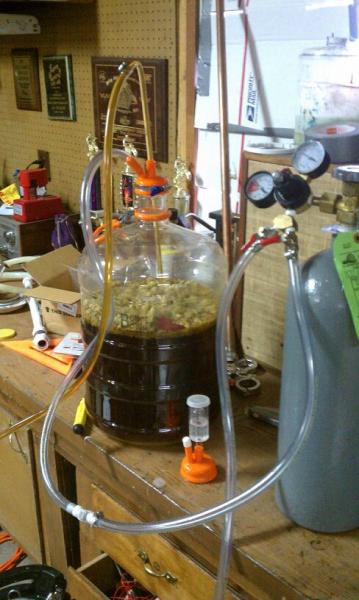I built this gizmo and just tested it today successfully with water:

This is primarily intended to transfer using a siphon from a carboy to another carboy, or from a carboy to a keg. It should also work to transfer using pressure, assuming the carboy cap doesn't blow off (I haven't tested this mode). The idea is to keep the beer in the primary carboy and in the secondary carboy under a CO2 blanket, and to conserve CO2 by transferring the CO2 in the pre-purged secondary into the primary carboy headspace as the beer goes from the primary to the secondary.
I used PVC ball valves because they are cheap (about $2.50 each) - they will work fine with low pressure (<5 psi). I used threaded valves and barb connections because I already had some of the parts on-hand and because I didn't want to glue pieces together (worried about the odor of the glue getting into my beer), but you could use non-threaded valves and short pieces of PVC pipe glued together.
The beer is transferred using racking canes inserted into the carboy caps, and connected with a piece of 3/8 inch silicone tubing (easy on and off, no clamps needed, and sanitization by boiling). The apparatus is connected with the CO2 hooked up to the brass flare connector at the left, with CO2 pressure turned all the way down. The carboy cap on the left is placed on the primary carboy which is sitting up on a table and the cap on the right is placed on the secondary carboy (or the tube could be connected to a keg gas disconnect). The sanitized silicone beer transfer line is connected to the secondary racking cane, with the other end initially connected to the 3/8 inch barb fitting on the left end of the assembly, which is used to purge the secondary.
Start with all valves closed.
Turn on the CO2 with 0 pressure
Open the PVC ball valve on the right end to vent the secondary
Open the PVC ball valve at top left to purge the secondary through the racking cane (or purge the keg through the beer out tube)
Turn up the CO2 pressure to the desired level to purge the secondary (I haven't yet determined this value)
After the purge, close the PVC purge valve and the vent valve, and reduce CO2 pressure to 0
Remove the end of the silicone line from the 3/8 barb fitting and place it on the primary racking cane so it can transfer beer from cane to cane or from cane to keg beer out tube
Open the PVC vent valve and the PVC valve at bottom left to allow CO2 to flow into the primary headspace to start the siphon
Turn up the CO2 pressure until you have a good flow and the level in the secondary is high enough to cover the bottom of the cane or beer out tube in the keg
Close the PVC valve at bottom left and the vent valve at the right, and open the middle valve to connect the two headspaces and allow the beer to siphon - the beer into the secondary pushes out an equal volume of CO2 which returns to the primary. When done, close all valves, remove the carboy cap from the secondary and apply airlock, or remove gas and beer disconnects from keg.
To use this as a straight pressure transfer device, just leave the left and right valves open and center valve closed the same as starting the siphon.









